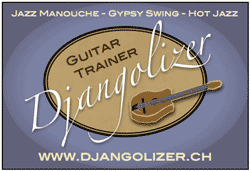
The Gypsy Guitar
In Jazz music, the guitar often sounds warm and smooth. It's
usually
played with an Archtop Jazz guitar connected to a Polytone amplifier.
Sometimes a chorus effect is added.The traditional Gypsy Jazz is played on an accoustic Selmer Maccaferri Style guitar, which gives this music the original sound and charme.
Selmer-Maccaferri Guitars
Selmer, a factory for great saxophones, branches out into guitar manufacture in partnership with stringed-instrument maker Mario Maccaferri in 1932.The partnership ended already in 1933, but Selmer still produced the guitar model N° 807 until 1952, which was played by Django Reinhardt.
Contrary to the Western style guitar, the Selmer guitar has a small, oval sound hole, called "petit bouche" or a big hole in a D-shape, called "D-hole" or "grand bouche".
The Gypsy guitar has always a cutoff, which supports the soloing in the higher regions. Some guitars have a neck with 12 frets and some have 14 frets. The neck with 14 frets is more comfortable for playing solos.
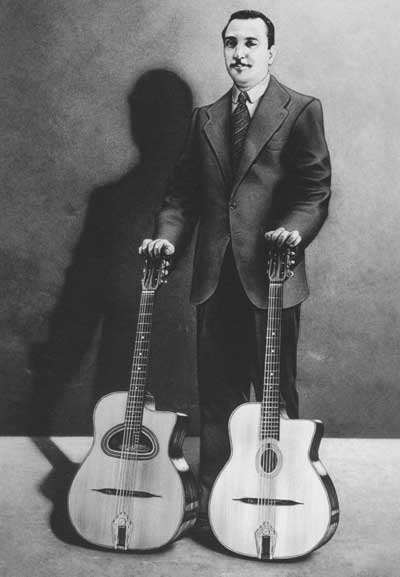
at left: Selmer "grand bouche" with 12 frets neck length
at right: Selmer "petit bouche" with 14 frets neck length
Compared to the Western guitar, the Gypsy guitar sounds crispier and more metallic, a little bit like a Dobro guitar. This supports the Gypsy rhythm playing, especially the "pompe" (french, the pump).
Buying a Gypsy Guitar
If you want to buy a Maccaferri Style guitar, you have to check, if it's loud enough. When you play with some friends, and all of them play "la pompe" in an enthusiastic way, you may not hear what you're soloing. Once, this happend to me and so I tried to play as loud as I could and hacked the pick in the strings until I got a cramp and my solo refused to swing and flow no more.For buying a guitar in a shop, you should go with another guitarplayer. He can accompaign you and you can test, if the guitar is well playable and loud enough. Then you should change the guitars and you can hear, how the guitar will sound to your audience. Probably very different.
In my opinion, it's impossible to buy a good guitar in the internet. How will you know, how it sounds? How will you know, if your fingers feel comfortable with the neck? Even, if you like the guitar of a friend and now you want to order the same model, it will not sound the same. Every guitar sounds different.
Once I tested five chinese gypsy guitars in a shop. They had serial numbers in ascending order. Each one of them sounded completely different !!!
Conclusion:
A good guitar has a good sound, is loud and the neck is comfortable to play and only then it matters, if it looks nice.
A good guitar has a good sound, is loud and the neck is comfortable to play and only then it matters, if it looks nice.
Gypsy Swing is a traditional music and the most Gypsy Guitars are still made by hand and in Europe. Such Selmer copies can cost between 1300.- and 4500.- Euro.
More and more Gypsy Guitars are made in China now. The price of those guitars starts at 300.- Euro and some of them sound quite well (for the price).
Here you find links to good luthiers
String action
It's common, to tune the neck of Western guitars, to set the strings low. With low strings, the guitars are easier and faster to play.Gypsy Guitars are different. It is better to have the strings quite high, because of the hard attack of the reststroke picking. Once, I checked a Gypsy guitar in a shop, wich had the strings low like an electric guitar. I couldn't play fast, because the strings touched the frets and they couldn't swing properly. Result: The guitar sounded weak. You can say, the higher the strings, the louder the guitar.
Fortunately, the luthier Maccaferri was a genius and constructed the guitar with an exchangeable bridge (le moustache). Some guitars are sold with two bridges, a high and a low one. If your guitar has a low bridge, you can put two pieces of wood under the moustache at the left and the right side.
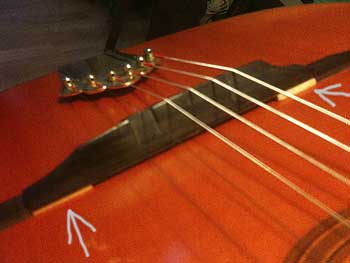
Try different heights to find out, how the feeling of playing and the sound of the guitar changes. Start with the thickness of 1mm and then grind it little by little down. Sometimes a few tenth millimeters can make a big difference.
It's worth to check this out, before you buy a new guitar.
The Pick
The "normal" picks from the guitar shop around the corner are not very useful for Gypsy Jazz.The thickness of a Gypsy-pick is between 2 and 5 millimeters. The thicker the pick, the stronger the tone.
It's amazing, how the pick can influence the sound and loudness of your guitar.
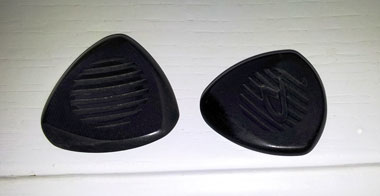
Wegen Trimus 350 (3.5mm) and Dunlop Fat Pick (5mm)
I like the Wegen-picks from Holland very much. My favourite is the "Trimus". Because it is a triangle, it lasts three times longer than a normal pick.
Dugain is another brand, wich is used by Gypsy players. Dugain picks are made of wood, bone, gemstone and metal. Each material sounds different and it is up to you, to find out, which one you prefer.
The Strings
The best strings are those, wich last the longest without breaking or rusting.The most used are probably the "Argentine" from the brand Savarez. They sound very authentic. The weakest string is the G-string. It usually breaks first. It's a good idea, to buy some of them as spare strings.
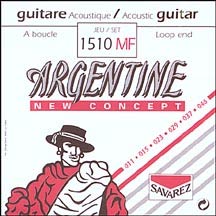
Each factory has strings with a different sound. If you're not happy with the sound of your guitar, try different strings.
Pick-Up and Amplifier
Because I prefer to play Gypsy Jazz acoustic, I don't have many tips here to share with you.I'm a simple man and so I just put a dynamic microphone in front of my guitar, which is connected to an amplifier or the PA. There are clip-microphones on the market wich you can clip to the sound hole. The problem with microphones is, that they like to produce feedback.
That's why some guitars have a built-in sound pickup.
Django used at the end of his career an electromagnetic pickup, which gave him a more American Jazz sound.
Good acoustic guitar amplifiers are from AER (Germany) and Schertler (Swiss Made). Both brands are not cheap, but give you a very good sound quality!
For a nice jazzy sound, there are also neat amps from "Pêche à la mouche".



